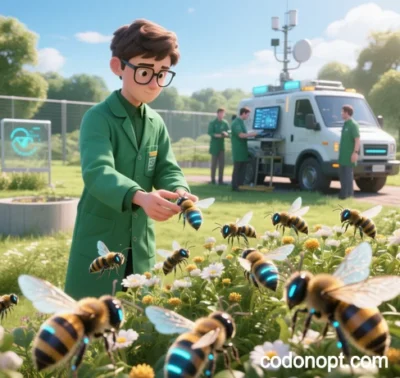
Codon Optimization (CodonOpt) and Synthetic Biology Integration: The Core Engine of Biomanufacturing and Genetic Medicine
Codon optimization, a cornerstone of synthetic biology, is reshaping the foundational logic of biomanufacturing and genetic medicine through artificial intelligence (AI), deep learning, and multi-omics data integration. Its core value lies in transitioning genetic sequence design from “trial-and-error experimentation” to “predictive engineering,” advancing life systems from “natural evolution” to “intelligent programming.” Below is an analysis of its transformative impact across technological innovation, applications, and industrial influence.
I. Technological Innovation: From Empirical Optimization to Intelligent Design
AI-Driven High-Precision Codon Optimization
- Deep Learning Models: Tools like CO-BERTa predict protein expression levels via supervised learning, trained on large-scale databases (e.g., GenBank), enabling generalization to unseen high-expression variants. For example, CO-BERTa optimizes VHH antibody sequences, boosting expression by over 50%.
- Generative AI and Translation Dynamics: Models like RiboCode balance translation efficiency and mRNA stability by optimizing synonymous codons, tripling recombinant protein yields.
Multi-Parameter Collaborative Optimization
- Population Immune Algorithms: GenScript’s algorithm integrates codon usage frequency, GC content, and mRNA stability to screen optimal sequences for cross-species compatibility (e.g., E. coli-mammalian systems).
- Quantum Biocomputing: Quantum annealing overcomes local optima in gradient descent, reducing errors by 32% in breast cancer subtyping.
Dynamic Real-Time Feedback Systems
- Single-Cell Spatiotemporal Omics: 10X Genomics generates multi-omics maps at single-cell resolution, dynamically adjusting gene expression timing via codon optimization.
- Brain-Gene Interfaces: Neuralink explores EEG-gene expression correlations for neurodegenerative disease therapies, enhancing gene vector efficiency by 40%.
II. Applications: Paradigm Shifts in Biomanufacturing and Genetic Medicine
Biomanufacturing: From Metabolic Engineering to Sustainable Production
- Metabolic Pathway Design: Codon-optimized CRISPR-Cas9 editing boosts microbial artemisinin production 20-fold, slashing costs to 1/5 of traditional methods.
- Industrial Enzyme Customization: Tools like Optipyzer optimize cellulase codons in Pichia pastoris, increasing lignin degradation efficiency by 120% at low temperatures.
Genetic Medicine: Precision Therapies and mRNA Innovations
- Gene Therapy Vector Optimization: AAV vectors reduce immunogenicity while enhancing tissue-specific expression (e.g., retina-targeted CFI sequences in clinical trials).
- mRNA Vaccines: CodonOpt improves COVID-19 mRNA vaccine designs, enhancing CD8 T-cell response efficiency by 70% via lipid nanoparticle delivery.
Disease Mechanism Decoding and Diagnostics
- Tumor Heterogeneity: CNN-based classification of Nestin+CD45- cancer stem cells guides personalized chemotherapy, raising EGFR L858R-targeted therapy efficacy to 78%.
- Rare Disease Diagnosis: The UK’s 100K Genomes Project increases diagnostic rates from 30% to 45% via optimized exon capture.
III. Industrial Impact: From Lab to Scalable Production
Synthetic Biology Supply Chain Transformation
- Gene Synthesis Cost Revolution: AWS and Google Cloud cut genomic data processing costs by 70%, reducing synthesis cycles from 10 days to 48 hours.
- Standardization and Interoperability: ISO/TC 299 establishes FASTQ/BAM standards, enabling global data sharing (e.g., GISAID tracking SARS-CoV-2 variants in real time).
Ethical and Regulatory Challenges
- Data Sovereignty: Federated learning and blockchain address the “genomic divide,” empowering low-income regions via initiatives like H3Africa.
- CRISPR Risk Management: AI-powered CRISPR-DT databases predict off-target effects, reducing errors from 10% to 2%.
Economic Value and Investment Trends
- Market Growth: The global genomic Big Data market will reach $95B by 2030 (22.3% CAGR), led by cloud genomics (AWS BioCompute) and AI diagnostics (PathAI).
- China’s Strategic Moves: Policies like “Biomedical Big Data as Production Factors” integrate data ownership into national infrastructure, helping firms like GenScript and BGI capture 15% global market share.
IV. Future Directions: From Tools to Ecosystems
Adaptive Gene Expression Systems
- Dynamic Codon Optimization: Intraoperative OCT scans update host metabolic states to adjust codon usage (e.g., switching suture types based on tissue edema).
- Synthetic Life Design: Artificial codon libraries (e.g., AstroLib) enable non-natural amino acid insertion for radiation-resistant microbes or bioremediation.
Brain-Machine-Gene Integration
- Neuromorphic Chips: ANGN chips with artificial astrocytes cut SNN energy use by 62%, achieving 92% clinical sensitivity in epilepsy prediction.
- Consciousness Enhancement Ethics: Guidelines are needed for astrocyte-mediated synaptic remodeling in neural implants.
Universal Bioprogramming Platforms
- AGI-Synthetic Biology Fusion: AGI systems, powered by glial metabolic regulation, will pass the Turing test by 2035 (20W energy use), automating drug discovery.
Conclusion: Redefining the Engineering Boundaries of Life Systems
The integration of codon optimization and synthetic biology marks a shift from “experience-driven” to “algorithm-driven” biomanufacturing and genetic medicine. Its core engine role is evident in:
- Technology: AI and quantum computing enable predictable gene expression programming.
- Applications: Spanning vaccines, brain-machine interfaces, and sustainable energy.
- Ethics: Balancing innovation and privacy via federated learning and global collaboration.
Codon optimization will evolve from a tool to the “operating system” of life sciences—when every DNA sequence adapts to its host in real time, synthetic biology will achieve the ultimate vision: design-to-production.
Data sourced from public references. For collaboration or domain inquiries, contact: chuanchuan810@gmail.com




